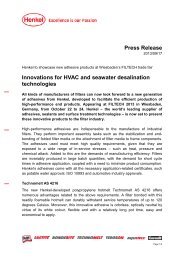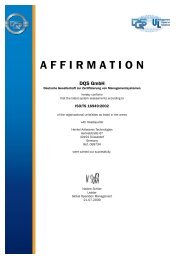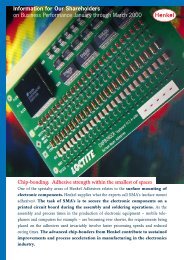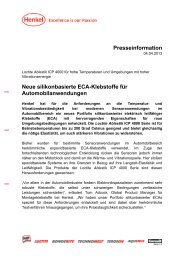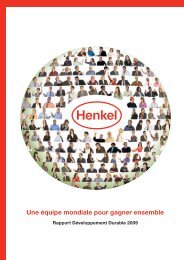Henkel Annual Report 2011 - Henkel AG & Co. KGaA Annual Report ...
Henkel Annual Report 2011 - Henkel AG & Co. KGaA Annual Report ...
Henkel Annual Report 2011 - Henkel AG & Co. KGaA Annual Report ...
Create successful ePaper yourself
Turn your PDF publications into a flip-book with our unique Google optimized e-Paper software.
132 <strong>Co</strong>nsolidated financial statements<br />
Notes to the consolidated statement of financial position<br />
<strong>Henkel</strong> <strong>Annual</strong> <strong>Report</strong> <strong>2011</strong><br />
For forward exchange transactions, the fair value is determined<br />
on the basis of the reference exchange rates of the<br />
European Central Bank prevailing at the reporting date, taking<br />
into account forward premiums/forward discounts for the<br />
remaining term of the respective contract versus the contracted<br />
foreign exchange rate. Foreign exchange options are<br />
measured using price quotations or recognized models for<br />
the determination of option prices. Interest rate hedging<br />
instruments are measured on the basis of discounted cash<br />
flows expected in the future, taking into account market<br />
interest rates applicable for the remaining term of the<br />
contracts. These are indicated for the two most important<br />
currencies in the following table. It shows the interest rates<br />
quoted on the interbank market in each case as of December 31.<br />
Interest rates in percent p.a.<br />
At December 31<br />
EUR USD<br />
Term<br />
2010 <strong>2011</strong> 2010 <strong>2011</strong><br />
3 months 0.96 1.36 0.48 0.69<br />
6 months 1.23 1.84 0.40 0.76<br />
1 year 1.51 1.95 0.88 1.23<br />
2 years 1.53 1.29 0.82 0.75<br />
5 years 2.50 1.73 2.23 1.27<br />
10 years 3.35 2.42 3.56 2.10<br />
Due to the complexities involved, financial derivatives entered<br />
into as hedges of commodity price risks are primarily measured<br />
on the basis of bankdeveloped simulation models, which are<br />
derived from market quotations. Regular plausibility checks<br />
are performed in order to safeguard valuation correctness.<br />
In measuring derivative financial instruments, counterparty<br />
credit risk is taken into account with a lumpsum adjustment<br />
to the fair values concerned, determined on the basis of<br />
credit risk premiums. The adjustment relating to fiscal <strong>2011</strong><br />
amounts to 4.8 million euros (previous year: 0.8 mil lion euros).<br />
The addition was expensed under financial result.<br />
Depending on their fair value and their maturity on the reporting<br />
date, derivative financial instruments are included in<br />
financial assets (positive fair value) or in financial liabilities<br />
(negative fair value).<br />
Most of the forward exchange contracts and currency options<br />
serve to hedge risks arising from trade accounts receivable<br />
and payable, and those pertaining to Group financing in US<br />
dollars.<br />
The interest rate hedging instruments are entered into in order<br />
to manage the interest rate risks arising from the fixedinterest<br />
bonds issued by <strong>Henkel</strong> <strong>AG</strong> & <strong>Co</strong>. <strong>KGaA</strong> and the floating<br />
interest bank liabilities (loans and overdrafts) entered into<br />
by <strong>Henkel</strong> of America, Inc. See also the following explanations<br />
relating to fair value hedges and cash flow hedges, and<br />
also with respect to the interest rate risk exposure of the<br />
<strong>Henkel</strong> Group.<br />
To a lesser extent, commodity derivatives are used to hedge<br />
uncertainties in future commodity price developments. See<br />
also the explanations relating to other price risks on page 138.<br />
Fair value hedges: A fair value hedge hedges the fair value of<br />
recognized assets and liabilities. The change in the fair value<br />
of the derivatives and the change in the fair value of the<br />
underlying relating to the hedged risk are simultaneously<br />
recognized in profit or loss.<br />
Receiver interest rate swaps are used to hedge the fair value risk<br />
of the fixedinterest bonds issued by <strong>Henkel</strong> <strong>AG</strong> & <strong>Co</strong>. <strong>KGaA</strong>.<br />
The fair value of these interest rate swaps is 199 million euros<br />
(previous year: 185 million euros) excluding accrued interest.<br />
The changes in fair value of the receiver interest rate swaps<br />
arising from market interest rate risks amounted to 14 million<br />
euros (previous year: 72 million euros). The corresponding<br />
changes in fair value of the hedged bonds amounted to<br />
–15 million euros (previous year: –69 million euros). In determining<br />
the fair value change in the bonds (see also Note 17 on<br />
page 126), only that portion is taken into account that<br />
relates to the interest rate risk.<br />
The following table provides an overview of the gains and losses<br />
arising from fair value hedges (valuation allowance made for<br />
the counterparty credit risk not included):<br />
Gains and losses from fair value hedges<br />
in million euros 2010 <strong>2011</strong><br />
Losses (–) from hedged items – 69 –15<br />
Gains (+) from hedging instruments 72 14<br />
Balance 3 –1<br />
Cash flow hedges: A cash flow hedge safeguards against the<br />
fluctuations in future cash flows from recognized assets and<br />
liabilities (in the case of interest rate risks), and also transactions<br />
that are either planned or highly probable, or firmly<br />
contracted unrecognized financial commitments, from<br />
which a currency risk arises. The effective portion of a cash<br />
flow hedge is recognized in the hedge reserve under equity.<br />
Ineffective portions arising from the change in value of the<br />
hedging instrument are recognized through profit or loss in<br />
the financial result. The gains and losses associated with the<br />
hedging measures initially remain in equity and are subsequently<br />
recognized through profit or loss in the period in<br />
which the hedged transaction influences the results for that<br />
period. If the hedging of a contracted item subsequently<br />
results in the recognition of a nonfinancial asset, the gains<br />
and losses recognized in equity are usually assigned to the<br />
asset on its addition (basis adjustment).



